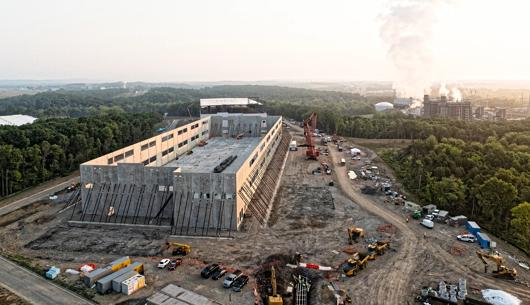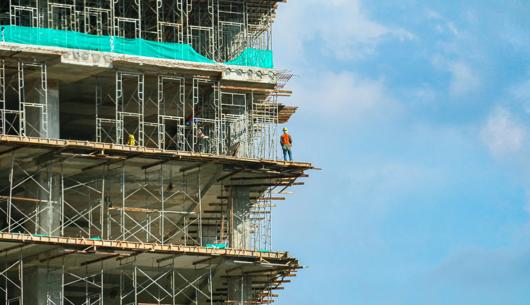The Levelling-up and Regeneration Bill received Royal Assent on 26 October 2023 and has therefore now become the Levelling up and Regeneration Act 2023 (LURA).
The Act follows the Government’s “Levelling Up the United Kingdom” White Paper, which was issued in February 2022 and, according to the Government, will speed up the planning system, hold developers to account, cut bureaucracy, and encourage more councils to put in place plans to enable the building of new homes.
The Levelling up and Regeneration Act 2023 is very long, at over 500 pages, and, although the Act itself has received Royal Assent, very few of the key provisions have actually come into force and a number of these will be subject to further regulations which will provide the detail.
We have provided a brief summary of some of the new ideas included in the Levelling up and Regeneration Act 2023 that may come forward at a later date, and possible next steps we can expect to see.
Infrastructure Levy
- Regulations may be made to introduce a new Infrastructure Levy. If introduced, this will be mandatory for local authorities in England and would fund delivery of new infrastructure to support communities living in new housing developments.
- Once the Infrastructure Levy is introduced, an Infrastructure Levy charging schedule and Infrastructure Delivery Strategy will need to be prepared and implemented by the charging authority (the local planning authority in most cases). The amount of levy to be paid would be based on a proportion of the development value of the land.
- Once regulations are introduced, we expect “test and learn” authorities to operate the Levy from 2025/26, with a target for full rollout from 2030. The existing section 106 regime will continue to apply.
Environmental Outcome Reports
- Environmental Outcome Reports (EORs) are introduced in the Levelling up and Regeneration Act 2023. This will be a new system of evaluating the environmental impacts of plans and projects. This will replace the current EU-derived processes of Strategic Environmental Assessment (SEA) and Environmental Impact Assessment (EIA).
- EORs will be centred around defined outcomes relating to environmental protection. The EORs’ findings of expected environmental impacts, mitigation and recommendations must be taken into consideration when determining if and on what conditions the consent will be given.
- It is expected that matters such as biodiversity, air quality, landscape, water, waste, and cultural heritage will be the sorts of outcomes to be assessed using EORs. Consultation on the draft outcomes is expected in due course.
- As with the Infrastructure Levy, timings are uncertain and regulations will need to be brought forward to provide much of the detail needed.
S.73B material variations to planning permissions
- A new power is included in the Levelling up and Regeneration Act 2023 under section 73B of the Town and Country Planning Act 1990 (TCPA), which allows for material changes to existing planning permissions without requiring a new application, so long as its effect will not be “substantially different from that of the existing permission”.
- An original planning permission is needed to use section 73B and, like section 73 of the TCPA, this cannot be used to extend the life of the permission.
National Development Management Policies (NDMPs)
- NDMPs are introduced in the Levelling up and Regeneration Act 2023 as a new level of national planning policy to be considered in the process of planning decision-making — particularly in determinations that are made under the “Planning Acts”, which would include planning applications. LPAs must also have regard to NDMPs in preparing the local plan.
- It appears that the intention behind NDMPs is to cover issues of national importance such as climate change, green belt, and heritage.
- The detail as to what will be contained in NDMPs is limited at this stage, but these will be key decision-making documents should these provisions be implemented in the context of planning decision making.
Street votes
- The Levelling up and Regeneration Act 2023 introduces a new street votes process, where street vote development orders can be made by the Secretary of State on behalf of a group of individuals. These will grant planning permission for the development specified in the order for a particular area.
- Certain development is excluded from inclusion in street vote development orders (this includes things like NSIPs, development of a scheduled monument, Schedule 1 EIA development and development of a listed building) but, generally, the scope is relatively wide.
- Regulations will be brought forward by the Secretary of State, which will include much more detail about how street votes will work.
Combined County Authorities (CCAs)
- The Levelling up and Regeneration Act 2023 creates a new type of combined authority for England. The new CCAs are designed for more rural areas, whereas the existing Combined Authorities (CA) typically cover cities. CCAs are made of upper-tier authorities only (although district/borough councils can become non-voting members if certain conditions are satisfied).
- Specific authorities are able to prepare a proposal for the establishment of a CCA for an area and submit this to the Secretary of State. The Secretary of State may make regulations establishing a CCA for an area only if it:
- is likely to improve the economic, social and environmental well-being of some or all of the people who live or work in the area;
- is appropriate, having regard to the need:
- To secure effective and convenient local government, and
- To reflect the identities and interests of local communities;
- will achieve the purpose specified to be achieved in the application from the authority;
- receives the Constituent Council’s consent; and
- a consultation has been carried out.
Enforcement: extension of the 4-year rule and warning notices
- Section 171B of the TCPA has been amended to extend the time limit to enforce planning breaches from 4 years to 10 years in England; consequently, this may relieve some pressure on authorities with limited resources.
- The Levelling up and Regeneration Act 2023 also introduces a new power for local planning authorities in England to issue enforcement warning notices, which would be used prior to enforcement proceedings.
- Although, again, these provisions are not yet in force, the change to the 4-year rule aims to encourage developers to comply with the planning system and to seek planning permission before carrying out development, rather than relying on the current 4-year rule to avoid enforcement action. The introduction of enforcement warning notices should also allow enforcement issues to be resolved without the need to issue enforcement proceedings.
Anticipated next steps
- Many provisions in the Levelling up and Regeneration Act 2023 will not be immediately effective, as they are subject to necessary further secondary legislation and changes to the National Planning Policy Framework. Leading commentary has likened the Levelling up and Regeneration Act 2023 to a “prelude to numerous new regulations on numerous topics, and is therefore more of a work in progress at this stage”.
- The Government’s Levelling up and Regeneration Act 2023 consultation document gives us an indication of statutory implementation dates for some of the changes, particularly in the context of plan-making. In this document, the Government anticipates that reforms to the plan-making system will be implemented from late 2024, and have set out a proposed timeline for altering to this new system:
30 June 2025: cut-off date for old-style plans to be submitted for examination
Plan makers will need to submit their local plans, neighbourhood plans, minerals and waste plans, and spatial development strategies for independent examination under the existing legal framework before 30 June 2025.
31 December 2026: latest date for any old-style local and minerals and waste plans to be adopted
All independent examinations of local plans, minerals and waste plans and spatial development strategies must be concluded, with plans adopted, by 31 December 2026.
April 2027
First new-style plans to be adopted.
With a general election on the horizon, there is uncertainty as to when these reforms will actually be brought forward. Much of the Levelling up and Regeneration Act 2023 will not come into force until the Secretary of State introduces Regulations to that effect — the power to make these regulations for a number of these provisions kicks in 2 months after the Levelling up and Regeneration Act 2023 came into force (i.e. Boxing Day), so we may have more certainty as to when and whether these reforms will come forward in the new year.










































